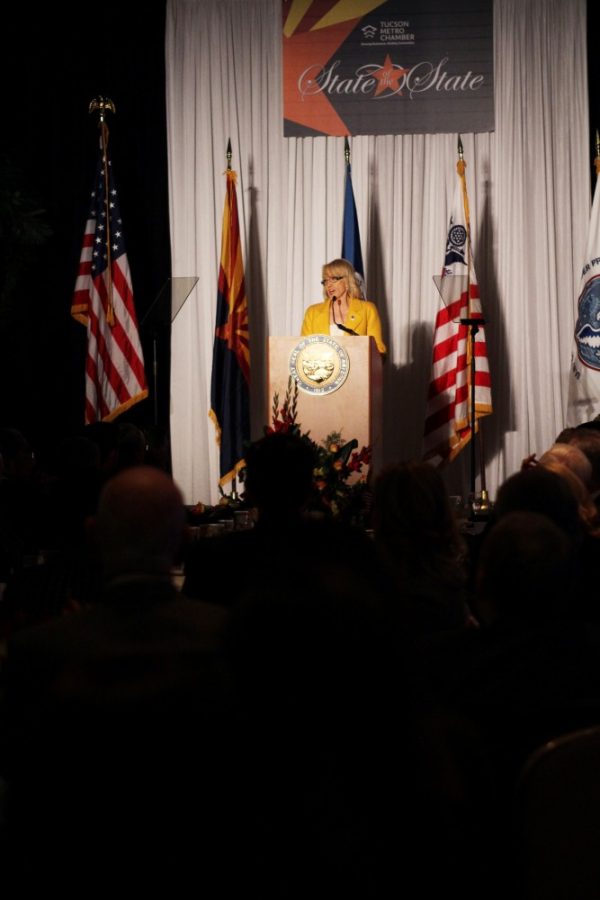The UA is taking the biggest hit in Gov. Jan Brewer’s budget proposal, Arizona Board of Regents chairman Rick Myers said Tuesday.
Last Friday, Brewer released the state’s Executive Budget proposal outlining the state’s intended expenses for fiscal year 2015. The proposal includes a two-page summary of higher education funding that suggests a $27.5 million allocation to Arizona State University and Northern Arizona University to help even out per-student funding throughout the three state universities.
While there is some funding for the UA in the proposal, it is roughly 10 percent of the $34.8 million the university requested. The $3.5 million would be available only for use for Cooperative Extension, a statewide network through the UA’s College of Agriculture and Life Sciences that links university research to Arizona’s community, environment and economy, according to its website.
The UA’s funding request was mirrored by the funding recommendation of the Arizona Board of Regents, the state’s higher education governing board. The board’s recommendations for all three universities totaled $107.6 million.
“I don’t want to imply anyone is out to get the University of Arizona, but I think we also need to be pragmatic and the students at the University of Arizona need to look and say, ‘We need the state to be committed to our university also so that our tuition can stay affordable and that we can have a quality experience,’” Myers said. “And the current proposal, I think, doesn’t support the University of Arizona enough.”
Myers said the regents are committed to their initial proposal and will continue to work with the Legislature and the governor’s office to modify the budget to include more funding for higher education.
UA leaders are taking a wait-and-see approach to the governor’s proposal, knowing that the funding they requested wasn’t guaranteed and they may have to make some adjustments according to the final budget.
Andrew Comrie, UA provost, said it was good to see some funding proposed for Cooperative Extension; however, the university will have to make some changes to the funding model for its strategic plan and to the plan’s goals if the state is unable to fund part of it. The Never Settle Strategic Academic and Business Plan focuses on innovation, student engagement, partnership and synergy.
“We set out a plan that has very ambitious goals in it, that has a full suite of funding needs, and we’re realists, knowing that not everything happens all the time,” Comrie said. “On the other hand, I think we make a really good case that if you really want this university to succeed and be put on the map, then I think it’d be great if everyone could pitch in to the best that they possibly can.”
The strategic plan is supported by a budget plan that suggests the state provide $15 million. The $15 million, along with a requested $11.8 million for performance funding, were left out of the executive office proposal. The UA also requested $8 million for the veterinary medicine degree and Cooperative Extension.
State university funding in the governor’s budget proposal totals $31 million, with an additional $15 million recommended for the Translational Genomics Research Institute, or TGen, an independent, nonprofit research organization that sometimes works with university researchers.
State Rep. Ethan Orr said he is concerned about the proposal’s lack of funding for the UA and would like to see the state budget switch to a performance-based funding model for higher education. The proposal defines performance-based funding as a model where additional funding is based on three metrics — total degrees awarded, credit hours completed and research expenditure — but doesn’t recommend additional funding for performance.
Orr, who is also vice-chairman of the Higher Education and Workforce Development Committee, added that while he supports the governor’s goal of a 0 percent tuition increase, he’s worried universities may not have the resources to avoid increasing tuition.
In order for institutions to cover their costs, they will have to cut internal costs, which might affect the quality of education, or they will need more money from either the state or an increase in tuition.
“It’s [not] feasible to say, ‘Institutions hold down tuition, but we’re not giving you more money,’” Orr said. “The money has to come from somewhere.”









